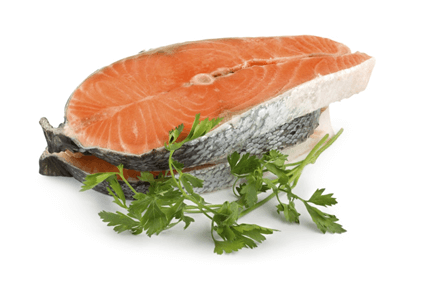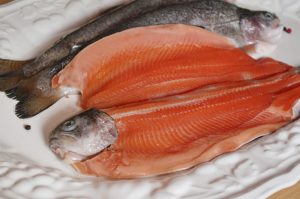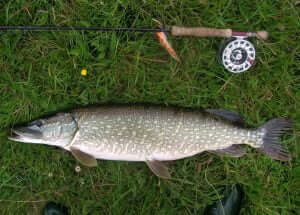
Fish is known as edible fish taken from saltwater or sweet and is available for consumption or sale.
Fish is a food rich in protein, phosphorus and other nutrients, which make it one of the most complete foods for children, people devoted to study and any other kind of person in general because of its easy digestion.
Purchase:
It must be bought in large establishments, chain stores or specialized fishmongers, where they contemplate all the rules of hygiene and sanitation, in terms of personnel, equipment of cooling and freezing and that has high turnover, because so it is sebe that it It treats fish in excellent condition due to its good manipulation and conservation.
Within many of the presentations of the fish that we can find in the market we have: fresh, frozen and salted or dry (conserved in Sal).
When you go to buy the product to the supermarket you should take into account,
- Observe that the refrigerator where the product is being exhibited is operating properly (which is cooling).
- Observe the expiration date of the product or its expiration, which is not covered, altered, or retreaded. Choose the product with date as far as Possible.
- Check the packaging, which is in optimal condition, not in a pinched, damaged or beaten position. Neither with broken or discarded labels.
- Check that the gasket is not inflated (blown), because this indicates that the product is already decomposing.
- Buy the product at the end of the market, so that the cold chain is not interrupted.
Do not leave a lot of time exposed to heat inside the car, or outside the freezer (because its lifespan is shortened), maximum 30 minutes not to interrupt “the cold chain” of Turkey, which prevents the proliferation of bacteria that cause disease.
If possible, it must be transported in a thermal bag and away from polluting products such as cleaners, automotive oils or petrol as it absorbs these smells.
Also when you arrive at your destination, place them immediately in the refrigerator.
Storage:
It is necessary to keep in mind the avoidance of “cross contamination”, that is to say, when storing a cooked fish should not be near one crude.
Conservation:
It is necessary to take care of its conservation, since it is a very delicate meat. It must be refrigerated or frozen immediately upon reaching its final destination.
FRESH FISH

Purchase:
Unfrozen fish should have a soft, fresh odor (not ammonia). If it has eyes, it should be shiny, crystalline (transparent) and bulging or bulging. Not flat or sunken, not cloudy or opaque.
Firm, non-tender, or inflated meat. Scales well adhered (although they may come without them). Soft, shiny, intensely colored skin. The guts are bright red and not opaque.
FROZEN FISH

Purchase:
The FROZEN FISH, it must be very hard. It should not have frost, or soft parts.
Soft odor to water, not strong to ammonia. If you have a head you must have crystalline, not cloudy or opaque eyes. Characteristic Color of each piece or specimen.
If it’s not cool it’s greyish, dull. You also see your yellow fat.
SALTED, DRY OR SALTED FISH.

Purchase:
Strong odor, dry and fibrous texture. Brownish yellow Color. Salty taste (must be subject to desalination process before you prepare it). Comes portioning in steaks.
FISH PORTIONED.
These are usually large fish that to facilitate their sale and service, they need to ration themselves.
Portions cuts.
- Fillets: It is made in horizontal cut, to remove a long slice without thorns. It can also be done in small or medium sized fish (shaft: bass fillets

FISH FILLETS
- Sliced or slices: transverse or vertical cut is made to remove the slice and the central spine is left. (Axis: Catfish slices)


WHOLE FISH.
These can be:
- Small: The sardine, the brunette, the Sierra, the blonde, etc. They are usually served whole, fried or grilled.
- Large: poaching (cooking in backgrounds, broths, salted water or in sauces) the liquid must be cold and slow cooking. Portioning is served in fillets or slices and usually in buffets.
BY THEIR ASSIMILATION THEY DIVIDE.
In:
- Whites: They are low-fat and easy to digest. There’s sea and river. They are, salmon, snook, cod, sole, huachinango, trout, etc.
- Blue: They are more greasy, difficult to digest. His flesh is not very white. Almost all of them are small sea fish of very strong flavor, such as sardines, anchovies or anchovies and herring. In this group can be included, tuna and bonito which are very large fish.
BY THEIR ORIGIN ARE DIVIDED.
In:
- Freshwater fish: Rich in potassium, phosphorus and magnesium. Among them are eel, carp, sturgeon, pike, salmon and trout.
- Sea fish: rich in iodine. Among them are pollock, herring, tuna, anchovies, huachinango, sole hake, halibut, bass, sardine.
When you go to buy the product to the supermarket you should take into account,
- Observe that the refrigerator where the product is being exhibited is operating properly (which is cooling).
- Observe the expiration date of the product or its expiration, which is not covered, altered, or retreaded. Choose the product with date as far as Possible.
- Check the packaging, which is in optimal condition, not in a pinched, damaged or beaten position. Neither with broken or discarded labels.
- Check that the gasket is not inflated (blown), because this indicates that the product is already decomposing.
- Buy the product at the end of the market, so that the cold chain is not interrupted.
Do not leave a lot of time exposed to heat inside the car, or outside the freezer (because its lifespan is shortened), maximum 30 minutes not to interrupt “the cold chain” of Turkey, which prevents the proliferation of bacteria that cause disease.
If possible, it must be transported in a thermal bag and away from polluting products such as cleaners, automotive oils or petrol as it absorbs these smells.
Also when you arrive at your destination, place them immediately in the refrigerator.
Uses:
Within all balanced diets should be included proteins and FISH is one of the most important sources to contribute to the organism this nutrient among MANY others. (See tips from this).
They are used as a strong dish or as an ingredient in countless preparations, since it is of great nutritional value and can use varied cooking methods.
Storage:
The day that is made market, when you get home, you have to have time not enough to organize: serving, packing, labeling and storing FISH, according to their subsequent use (cuts) and according to the number of people (diners) who feed at home each day , leaving lists, to keep them in the most appropriate way (refrigerate or freeze).
This will make the preparation of the food daily more agile, quick and practical. (see each meat Class).
Approximate weight per serving.
The meat (boneless) portion recommended is 125-200 gr. For adults.
For children the portions would be about 10-15 Gr. For every year of age.
Tips: It is advisable to know a little about the nutrients that the FISH consumption contributes to the human organism.
Example: Atlantic salmon (cooked).
Calories 206 for every 100 grams.
Fish has excellent nutritional value.
It provides high-quality proteins and a wide variety of vitamins and minerals, and nourishes the brain.
Among them:
Proteins:
They are essential for cell development (essential amino acids).
It is found in meats, poultry, fish, shellfish, eggs and some vegetables such as legumes (beans, soybeans, lentils), among Others.
Vitamin A.
- It is important for normal growth of children and adolescents.
- Protects the surface of the respiratory tract, throat, bronchi.
- Resistance to infection.
- Stimulates appetite.
- Good for digestion.
- It is used to prevent cancer (it is antioxidant).
- Improve skin, hair (hair) and eyes.
- Strengthen the immune system.
- Eye and skin protection.
VITAMIN B.
- Essential for transporting energy to cells and nerve tissue.
- For cardiovascular health and circulatory system.
Vitamin D.
- For the formation of strong bones and Teeth.
- Regulates Metabolism.
- Support for phosphorus and calcium absorption.
- For the brain.
- Maintain body weight.
Phosphorus.
- Along with the calcium it forms the cover of bones and teeth.
- For the proper functioning of the brain.
Magnesium.
- Essential for the correct functioning of the nervous system.
- Helps the functioning of the glands.
Selenium.
- It produces essential proteins (antioxidants) that prevent cell damage.
- It protects after a vaccine.
IODINE (sea fish).
It is vitally important for the proper functioning of the thyroid, which regulates the metabolism.
Calcium.
- It constitutes 50% of the minerals present in the human Body.
- Prevents Bleeding.
- It helps keep your heartbeat constant.
- For the maintenance and development of bones, fingernails and Teeth.
- Helps in blood clotting and good muscle functioning.
Fluor.
For the formation and hardening of bones and teeth.
Zinc.
- Improves the skin.
- It serves for the growth of children and adolescents.
- For healing the wounds.
Fat.
Fish is rich in unsaturated (beneficial) fats that help reduce blood cholesterol levels, which protect against heart disease.
The fish that the most unsaturated fats provide are: La Sardina, swordfish and herring.
Fish is one of the most omega-3 fatty acid foods, essential for cardiovascular health, as it reduces blood pressure and blockage of blood vessels.
Omega-3 also protects against cancer, arthritis and skin problems, such as psoriasis.
Excellent for the good functioning of the nervous system and brain.
NUTRIENTS THAT MUST HAVE ALL BALANCED DIET.
It should be remembered that for a balanced diet, food should be consumed from the 5 groups:
- Proteins: essential amino acids are essential for cell development.
It is found in meats, poultry, fish, shellfish, eggs and some vegetables such as legumes (beans, soybeans, lentils) among others.
- Carbohydrates (carbohydrates): They provide energy to the organism, such as food fibre and sugars.
They are found in vegetables such as wheat, potato, plantain and some fruits, among others.
- Lipids. Animal and vegetable fats.
- Vitamins. Fruits and vegetables and in the vast majority of food.
- Minerals. Fruits and vegetables and in the vast majority of food.
Then, any balanced diet must contain: meats, fruits, vegetables, cereals, legumes, dairy, eggs and fats (animal or vegetable).
Note: It should be remembered that the useful “life” of the product depends on its freshness at the time of purchase, the date (approximate) of maturity and its subsequent storage and conservation.
Periodically check the condition of the product (freezing date), in order to be able to consume it in time.
Always handle with clean hands or disposable gloves and those that have already been cooked, in addition to clean utensils.



